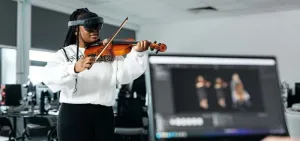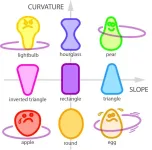(Press-News.org) Researchers are aiming to bring the magic of playing music in person to the virtual world.
The Joint Active Music Sessions (JAMS) platform, created at the University of Birmingham, uses avatars created by individual musicians and shared with fellow musicians to create virtual concerts, practice sessions, or enhance music teaching.
Dr Massimiliano (Max) Di Luca from the University of Birmingham explains: “A musician records themselves and sends the video to another musician. The software creates a responsive avatar that plays in perfect synchrony with the music partner. All you need is an iPhone and a VR headset to bring musicians together for performance, practice, or teaching.”
The JAMS platform has the potential to develop a social network like Spotify or Myspace, where musicians can interact to learn, connect, perform, develop new music, and create virtual concerts that reach larger audiences.
JAMS has the distinct flavour of a platform developed with and for musicians whether successful or at an early stage of learning.
The avatars capture the unspoken moments that are key in musical performance, allowing practice partners or performers to watch the tip of the violinist’s bow, or make eye contact at critical points in the piece. They also have real-time adaptability and are dynamically responsive to the musician on the VR headset, so delivering a unique, personalised experience.
Delivery by VR headset recreates the musician’s world and provides an immersive backdrop with a realistic rendering of other musicians and cues used in the real-life setting. It also keeps the faces at eye level, which adds to the feeling of connectedness.
Critically, there is no ‘latency’ in the JAMS user experience. Dr Di Luca explains: “Latency is the delay between a sound production and when it reaches the listener, and performers can start to feel the effects of latency as low as 10 milliseconds, throwing them ‘off-beat’, breaking their concentration, or distracting them from the technical aspects of playing.”
JAMS is underpinned by an algorithm created during the Augmented Reality Music Ensemble (ARME) project, that captures dynamic timing adjustments between performers. The project brought together researchers from six disciplines (psychology, computer science, engineering, music, sport science, and maths), whose input realised the vision of building a computational model that reproduces, with precision, a musician’s body movements and delivers an avatar that meets the needs co-performers.
“We’re aiming to bring the magic of playing music in person to the virtual world. You can adapt the avatar that other people play with, or learn to play better through practice with a maestro.”
JAMS allows musicians to perform in an interactive virtual group, and can be adapted for lipsyncing or dubbing in media. It can also gather unique user data to create digital twins of musicians, offering licensing opportunities for various applications, and further exploitation of catalogues and publishing rights.
Commercial enquiries should be directed to the ARME project website at: https://arme-project.co.uk/contact/
END
Bringing the magic of playing music to the virtual world
2025-01-02
ELSE PRESS RELEASES FROM THIS DATE:
Psychedelic drug therapy may address mental health concerns in people with cancer and addiction
2025-01-02
One or two doses of psilocybin, a compound found in psychedelic mushrooms, may improve the mental health of cancer patients when accompanied by psychotherapy, a new report suggests. A second new study found that treatment with psilocybin resulted in lasting, positive personality changes in patients with alcohol use disorder.
The first report’s findings were published online Oct. 7 in the journal Nature Mental Health, and the second published online Jan. 1 in a special edition of The American Journal of Psychiatry focused on psilocybin research.
In the first study, a team of experts at NYU Langone Health found that psilocybin accompanied by psychotherapy significantly reduced anxiety, ...
Too many men or too few women?—new study finds how the gender gap is framed affects perceptions of it
2025-01-02
To many, Vice President Kamala Harris’s loss in the 2024 presidential election was a sobering reminder of a larger and continuous gender gap across leadership positions in not only government, but also in business, higher education, and the military. A majority of Americans recognize the inadequacy of female representation in leadership, and the news media often portray women’s underrepresentation in these roles—but it nonetheless persists.
Recognizing that news coverage may have influence in forming attitudes and in driving ...
AI can improve ovarian cancer diagnoses
2025-01-02
A new international study led by researchers at Karolinska Institutet in Sweden shows that AI-based models can outperform human experts at identifying ovarian cancer in ultrasound images. The study is published in Nature Medicine.
“Ovarian tumours are common and are often detected by chance,” says Professor Elisabeth Epstein at the Department of Clinical Science and Education, Södersjukhuset (Stockholm South General Hospital), at Karolinska Institutet and senior consultant at the hospital’s Department of Obstetrics and Gynecology. “There is a serious shortage of ultrasound experts in many parts of the world, which has ...
Zebrafish protein unlocks dormant genes for heart repair
2025-01-02
Researchers from the Bakkers group at the Hubrecht Institute have successfully repaired damaged mouse hearts using a protein from zebrafish. They discovered that the protein Hmga1 plays a key role in heart regeneration in zebrafish. In mice, this protein was able to restore the heart by activating dormant repair genes without causing side effects, such as heart enlargement. This study, supported by the Dutch Heart Foundation and Hartekind Foundation, marks an important step toward regenerative therapies to prevent heart failure. The findings were published in Nature Cardiovascular Research on January 2, 2025.
After a heart attack, the human heart loses millions of muscle cells that cannot ...
How good are AI doctors at medical conversations?
2025-01-02
Artificial intelligence tools such as ChatGPT have been touted for their promise to alleviate clinician workload by triaging patients, taking medical histories and even providing preliminary diagnoses.
These tools, known as large-language models, are already being used by patients to make sense of their symptoms and medical tests results.
But while these AI models perform impressively on standardized medical tests, how well do they fare in situations that more closely mimic the real world?
Not that great, according to the findings of a new study led by researchers at Harvard Medical School and Stanford University.
For their analysis, published Jan. 2 in Nature ...
A speckle of hope for cancer patients
2025-01-02
Fighting cancer can seem like a deadly game of chance. While some patients may respond well to certain treatments, others might not be as fortunate. Doctors and scientists have long struggled to explain why. Now, Cold Spring Harbor Laboratory (CSHL) Assistant Professor Katherine Alexander and University of Pennsylvania Professor Shelley Berger have found a possible source of this variability in clear cell renal cell carcinoma (ccRCC)—the most common kidney cancer diagnosed in adults.
Alexander ...
How does a hula hoop master gravity? Mathematicians prove that shape matters
2025-01-02
Hula hooping is so commonplace that we may overlook some interesting questions it raises: “What keeps a hula hoop up against gravity?” and “Are some body types better for hula hooping than others?” A team of mathematicians explored and answered these questions with findings that also point to new ways to better harness energy and improve robotic positioners.
The results are the first to explain the physics and mathematics of hula hooping.
“We were specifically interested in what kinds of body motions and shapes could successfully hold the hoop up and what physical requirements and restrictions are involved,” explains ...
New method to measure 5G radiation from mobile phones and base stations
2025-01-02
A team of researchers from Project GOLIAT has developed and applied a new protocol to measure exposure to mobile phone radiation, in particular from 5G. The researchers measured radiofrequency electromagnetic field (RF-EMF) levels during three different scenarios: when the mobile device is in flight mode (non-user), when the mobile phone is used intensively by either downloading or uploading data. The study demonstrates that e.
The research was conducted in Switzerland, one of the first countries in Europe to roll out 5G networks on a large scale. The results have now been published in Environmental Research and provide relevant data for epidemiological ...
Artificial Intelligence Predicts Deutsche eMark (DEM) as the 2025 Crypto Sensation
2025-01-01
What Is Deutsche eMark (DEM)?
Deutsche eMark, often referred to by its abbreviation DEM, is a cryptocurrency that draws inspiration from reviving the legacy of the German Mark—Germany’s official currency before the introduction of the euro. The creators of DEM aimed to leverage the recognition of the traditional German currency by combining it with innovative blockchain technology.
The primary mission of the project is to enable fast and efficient transactions both within Germany and on the international market. By using a peer-to-peer network, Deutsche eMark seeks to offer low transaction costs while maintaining a high level of security.
Deutsche eMark, often referred to by its abbreviation DEM, is a cryptocurrency that draws inspiration from reviving the legacy of the German Mark—Germany’s official currency before the introduction of the euro. The creators of DEM aimed to leverage the recognition of the traditional German currency by combining it with innovative blockchain technology.
The primary mission of the project is to enable fast and efficient transactions both within Germany and on the international market. By using a peer-to-peer network, Deutsche eMark seeks to offer low transaction costs while maintaining a high level of security.
Revolutionizing heat management with high-performance cerium oxide thermal switches
2025-01-01
Groundbreaking cerium oxide-based thermal switches achieve remarkable performance, transforming heat flow control with sustainable and efficient technology.
Thermal switches, which electrically control heat transfer, are essential for the advancement of sophisticated thermal management systems. Historically, electrochemical thermal switches have been constrained by suboptimal performance, which impedes their extensive utilization in the electronics, energy, and waste heat recovery sectors.
A research team led by Professor Hiromichi Ohta of the Research Institute for Electronic Science, Hokkaido University employed a novel approach of ...





